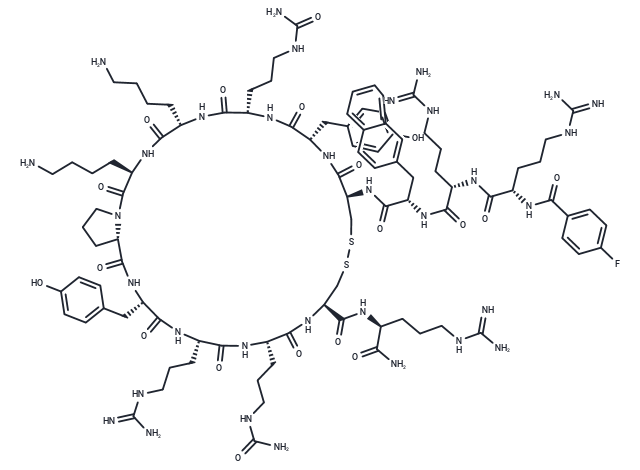Shopping Cart
Remove All Your shopping cart is currently empty
Your shopping cart is currently empty
Motixafortide (BKT140 4-fluorobenzoyl) is a CXCR4 antagonist with an IC50 of 1 nM.

| Pack Size | Price | USA Warehouse | Global Warehouse | Quantity |
|---|---|---|---|---|
| 25 mg | $747 | 7-10 days | 7-10 days | |
| 50 mg | $1,190 | 7-10 days | 7-10 days |
| Description | Motixafortide (BKT140 4-fluorobenzoyl) is a CXCR4 antagonist with an IC50 of 1 nM. |
| Targets&IC50 | CXCR4:1 nM |
| In vitro | Motixafortide (BKT140) exhibits selective toxicity against AmL and MM cells by specifically inducing CXCR4-dependent and apoptotic cell death in these leukemia and multiple myeloma (MM) cell types. Additionally, treatment with Motixafortide (BKT140) counteracts the IL-6 dependent proliferation and survival observed in ARH77 MM cells. |
| In vivo | Treatment with Motixafortide (BKT140) results in reduced size and weight of tumors in animals, alongside increased necrotic areas and elevated apoptotic scores[2]. Additionally, subcutaneous administration of Motixafortide (BKT140) markedly diminishes the growth of human acute myeloid leukemia and multiple myeloma xenografts in a dose-dependent fashion. |
| Synonyms | TF14016, BL-8040, BKT140 (4-fluorobenzoyl) |
| Molecular Weight | 2159.52 |
| Formula | C97H144FN33O19S2 |
| Cas No. | 664334-36-5 |
| Relative Density. | 1.52 g/cm3 (Predicted) |
| Sequence | {4-Fluorobenzoyl}-Arg-Arg-{2-Naph-Ala}-Cys-Tyr-{Cit}-Lys-{d-Lys}-Pro-Tyr-Arg-{Cit}-Cys-Arg-NH2 (Disulfide bridge: Cys4-Cys13) |
| Sequence Short | {4-Fluorobenzoyl}-RR-{2-Naph-Ala}-CY-{Cit}-K-{d-Lys}-PYR-{Cit}-CR-NH2 (Disulfide bridge: Cys4-Cys13) |
| Storage | keep away from moisture | Powder: -20°C for 3 years | In solvent: -80°C for 1 year | Shipping with blue ice/Shipping at ambient temperature. | ||||||||||||||||||||
| Solubility Information | DMSO: 36 mg/mL (16.67 mM), Sonication is recommended. | ||||||||||||||||||||
Solution Preparation Table | |||||||||||||||||||||
DMSO
| |||||||||||||||||||||
| Size | Quantity | Unit Price | Amount | Operation |
|---|

Copyright © 2015-2025 TargetMol Chemicals Inc. All Rights Reserved.